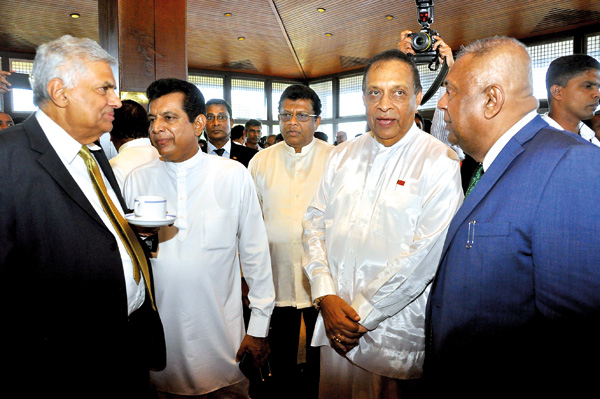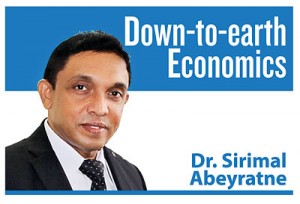Budget: Sailing in troubled waters
View(s):
Finance Minister Mangala Samaraweera with Prime Minister Ranil Wickremesinghe and Speaker Karu Jayasuriya at the traditional post-Budget tea party.Pic by Priyantha Wickramarachchi.

At last, Budget 2019 was presented four months after its due date and two months after its due implementation date in the current Financial Year. In the backdrop of challenging economic fundamentals, but contrary to that we wouldn’t have better numbers than those which appear in the Budget. Basically, these numbers can make almost everyone happy – the people, the government and, even the IMF.
Today I intend to discuss the overall budgetary outlook in the context of challenging economic fundamentals. In doing so, I won’t focus on each one of the revenue proposals and the expenditure proposals. There are lots of goodies among the expenditure proposals. If we like them, we must pay for them too; there are lots of tax proposals too.
Challenging backdrop
According to the Budget, the rate of real GDP growth that Sri Lanka achieved last year was 3 per cent – less than all the forecasted rates and, the lowest after 18 years. What is surprising to me is that this is in spite of Sri Lanka being in the fastest-growing region of the world – South Asia.
The second issue is the dismal export performance of the country that has led to a gradually aggravating trade deficit. During the first 11 months of 2018, Sri Lanka’s trade deficit has increased by US$1 billion to $9.6 billion from $8.6 billion during the corresponding period of 2017. The country has been struggling to make a breakthrough in its sluggish exports stagnant around $10 billion, compared to growing imports of over $ 20 billion.
As more productive and stable sources of foreign exchange inflows have become weaker, balance of payments has become increasingly exposed to more volatile foreign exchange inflows. The result has been the pressure on the exchange rate which was unable to stand against external shocks as the country witnessed during 2018. As one of the remedial measures, the Central Bank reduced foreign investment in government securities from 10 to 5 per cent of outstanding Treasury Bills and Bonds. This remedy would reduce the exchange rate volatility, but squeeze the balance of payments in the absence of adequate export growth.
Budgetary outlook
An important dimension of the country’s economic challenge was the weak budgetary management that has been aggravated in the recent past. On the revenue side, tax revenue had dropped from around 20 per cent of GDP to around 12 per cent of GDP, while the revenue was not sufficient even to cover the recurrent expenditure. This means that the entire public investment budget plus part of the recurrent expenditure was financed through borrowings. Furthermore, Sri Lanka started commercial borrowings after 2007.
Years and decades of borrowings got accumulated into outstanding debt, while the repayment is bunching up now. Foreign loan repayment alone is estimated to be $5.9 billion in 2019, equivalent to five times the cost of building the Hambantota Port! With increased borrowings, interest payment has become the largest recurrent expenditure item in the government budget. In the Budget 2019 too, interest payments require 38 per cent of recurrent expenditure.
Budgetary optimism
In spite of all the above, Budget 2019 looks comfortable and healthy. Total revenue is Rs. 2,451 billion, while its tax component is estimated to be Rs. 2,077 billion. Recurrent expenditure is estimated as Rs. 2,415 billion leaving a revenue surplus of Rs. 36 billion; this means that the Government expects to maintain its revenue higher than the recurrent expenditure, though it failed last year and, the year before and, so on. As a result, borrowings can easily cover the estimated public investment which amounts to Rs. 756 billion.
Another remarkable improvement is the gradual improvement in the primary balance, which is the total revenue and grants minus recurrent expenditure excluding interest payments. Primary balance which continued to be in a deficit, turned out to a surplus of Rs. 2 billion in 2017 and, improved to Rs. 91 billion in 2018; this is envisaged to improve further to Rs. 228 billion this year.
IMF priority area
Overall budget deficit is also expected to be 4.4 per cent of GDP this year, reduction from 5.3 per cent last year.
In its 5th Review of Sri Lanka’s Extended Fund Facility (EFF), the IMF as usual highlighted the need for continuous effort for sustained fiscal consolidation through both domestic revenue mobilisation and prudent spending which remains a priority to bring down high debt.
The numbers as above show the government effort to fiscal consolidation, in spite of the increase in total expenditure by Rs. 363 billion – almost Rs. one billion for each day of the year. How did we do that?
Direct tax revenue
It doesn’t look like the implementation of the 2018 Inland Revenue Act (IRA) has much to do with increased direct tax revenue. It has helped the Inland Revenue Department (IRD) to raise just a few billions of rupees above the normal increase.
Last year the Government anticipated to have increased the income tax by Rs.100 billion from Rs.275 billion in the previous year; but the actual increase has been only Rs.35 billion. The slower economic growth must have had its downward pressure on tax revenue. The major issue seems to be, however, the outdated tax administrative mechanism.
Although the IRA has been passed, Sri Lanka does not have an established population database which records people’s income and wealth, among other vital information. Therefore, the IRD has to follow its old-fashion method of chasing after individuals and inviting them to identify themselves. It is difficult to figure out how long it takes to cover all 21 million people of the country!
Still indirect
Because the government doesn’t know about people’s income, the easier way to catch them is when they spend. For this reason, indirect tax rates are multiple and rates are excessively high.
Although there has been much discussion in the past about the need for improving direct income tax share, it still remain around 18 per cent of total tax revenue leaving an overwhelming share of Rs. 2 trillion tax collection to come from indirect taxes.
Falling expenditure
Finally, here is a new policy dilemma: One of the main issues of budgetary outlays in the past has been “underestimated” expenditure which has often increased during the implementation above its estimates. Interestingly, this has changed in the reverse direction now; actual expenditure appears to be falling below the estimates. Last year the estimated total expenditure was Rs. 3,001 billion whereas the actual expenditure was Rs. 2,786 billion – Rs. 215 billion less than the estimate. The reduction is not only due to cut backs in public investment, but also due to under-spending in recurrent expenditure.
This is a peculiar issue which requires detailed research. One hypothesis could be the increased inefficiency in the public sector which is not capable of delivering what is proposed in the budget. The public sector inefficiency might have many different reasons such as incompetence, lengthy and complex bureaucratic procedures, coordination complexities among different agencies (including too many Ministries) and, the overdue reform agenda.
Even the Government’s expenditure disbursement issues might be another source of the inability to spend and deliver the output.
Flip side of the issue
The fall of actual expenditure below the estimates has a positive outcome: Correspondingly, the budget deficit will fall too and, thereby at least statistically we can show the progress in fiscal consolidation.
However, the issue has a flip side: Public sector performs a facilitating role in private sector-led economic growth. If that facilitating role is not actually facilitating economic growth, there is nothing to be surprised about falling growth performance.
If growth performance is not up to the desired level, apparently both direct and indirect tax revenue will also be at a dangerous position. It is vital to sustain a higher growth momentum in order to sustain a higher tax revenue. However, Sri Lanka’s actual tax revenue has always been below the estimates. (The writer is a Professor of Economics at the University of Colombo and can be reached at sirimal@econ.cmb.ac.lk).


